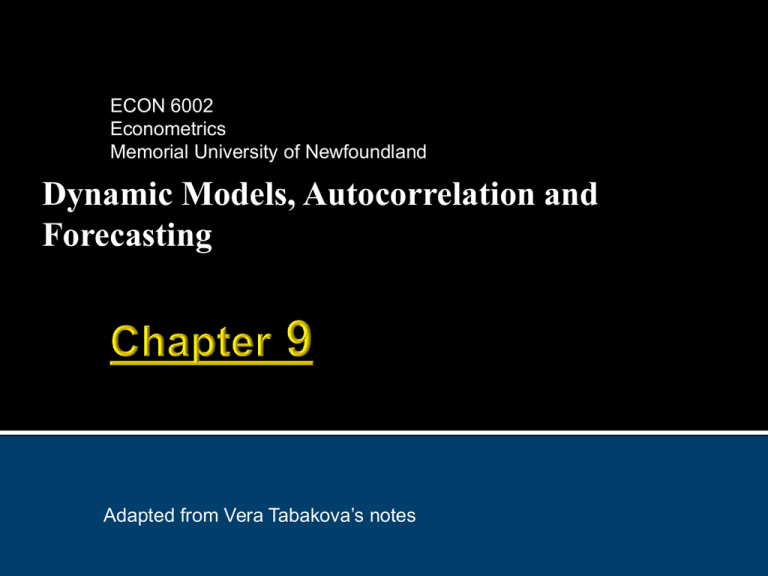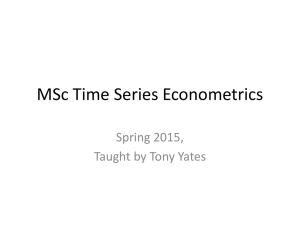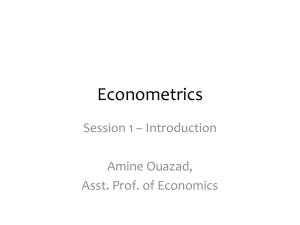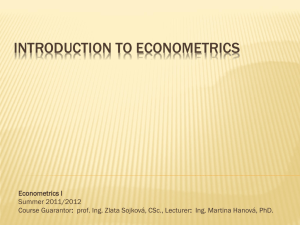ch09timeseries - Memorial University of Newfoundland
advertisement

ECON 6002 Econometrics Memorial University of Newfoundland Dynamic Models, Autocorrelation and Forecasting Adapted from Vera Tabakova’s notes 9.1 Introduction 9.2 Lags in the Error Term: Autocorrelation 9.3 Estimating an AR(1) Error Model 9.4 Testing for Autocorrelation 9.5 An Introduction to Forecasting: Autoregressive Models 9.6 Finite Distributed Lags 9.7 Autoregressive Distributed Lag Models Principles of Econometrics, 3rd Edition Slide 9-2 Figure 9.1 Principles of Econometrics, 3rd Edition Slide 9-3 The model so far assumes that the observations are not correlated with one another. This is believable if one has drawn a random sample, but less likely if one has drawn observations sequentially in time Time series observations, which are drawn at regular intervals, usually embody a structure where time is an important component. Principles of Econometrics, 3rd Edition If we cannot completely model this structure in the regression function itself, then the remainder spills over into the unobserved component of the statistical model (its error) and this causes the errors be correlated with one another. Principles of Econometrics, 3rd Edition Three ways to view the dynamics: yt f ( xt , xt 1 , xt 2 ,...) (9.1) yt f ( yt 1 , xt ) (9.2) yt f ( xt ) et Principles of Econometrics, 3rd Edition et f (et 1 ) (9.3) Slide 9-6 Assume Stationarity For now Figure 9.2(a) Time Series of a Stationary Variable Principles of Econometrics, 3rd Edition Slide 9-7 Figure 9.2(b) Time Series of a Nonstationary Variable that is ‘Slow Turning’ or ‘Wandering’ Principles of Econometrics, 3rd Edition Slide 9-8 Figure 9.2(c) Time Series of a Nonstationary Variable that ‘Trends’ Principles of Econometrics, 3rd Edition Slide 9-9 9.2.1 Area Response Model for Sugar Cane ln A 1 2 ln P ln At 1 2 ln Pt et (9.4) yt 1 2 xt et (9.5) et et 1 vt Principles of Econometrics, 3rd Edition (9.6) Slide 9-10 yt 1 2 xt et (9.7) et et 1 vt (9.8) E(vt ) 0 var(vt ) v2 Assume also Principles of Econometrics, 3rd Edition cov(vt , vs ) 0 for t s 1 1 (9.9) (9.10) Slide 9-11 E (et ) 0 2 var(et ) e2 v 2 1 cov et , et k e2k Principles of Econometrics, 3rd Edition (9.11) OK OK, constant k 0 Not zero!!! (9.12) (9.13) Slide 9-12 corr(et , et k ) cov(et , et k ) var(et ) var et k cov(et , et k ) e2k 2 k (9.14) var(et ) e corr(et , et 1 ) (9.15) Aka autocorrelation coefficient yˆt 3.893 .776 xt (se) (.061) (.277) Principles of Econometrics, 3rd Edition (9.16) Slide 9-13 Principles of Econometrics, 3rd Edition Slide 9-14 Figure 9.3 Least Squares Residuals Plotted Against Time Principles of Econometrics, 3rd Edition Slide 9-15 T rxy cov( xt , yt ) ( xt x )(yt y ) var( xt )var( yt ) Constant variance t 1 T T t 1 t 1 2 2 ( x x ) ( y y ) t t (9.17) Null expectation of x and y T r1 cov(et , et 1 ) var(et ) eˆt eˆt 1 t 2 T 2 ˆ e t 1 (9.18) t 2 Principles of Econometrics, 3rd Edition Slide 9-16 The existence of AR(1) errors implies: The least squares estimator is still a linear and unbiased estimator, but it is no longer best. There is another estimator with a smaller variance. The standard errors usually computed for the least squares estimator are incorrect. Confidence intervals and hypothesis tests that use these standard errors may be misleading. Principles of Econometrics, 3rd Edition Slide 9-17 As with heteroskedastic errors, you can salvage OLS when your data are autocorrelated. Now you can use an estimator of standard errors that is robust to both heteroskedasticity and autocorrelation proposed by Newey and West. This estimator is sometimes called HAC, which stands for heteroskedasticity autocorrelated consistent. Principles of Econometrics, 3rd Edition Slide 9-18 HAC is not as automatic as the heteroskedasticity consistent (HC) estimator. With autocorrelation you have to specify how far away in time the autocorrelation is likely to be significant The autocorrelated errors over the chosen time window are averaged in the computation of the HAC standard errors; you have to specify how many periods over which to average and how much weight to assign each residual in that average. That weighted average is called a kernel and the number of errors to average is called bandwidth. Principles of Econometrics, 3rd Editio Slide 9-19 Usually, you choose a method of averaging (Bartlett kernel or Parzen kernel) and a bandwidth (nw1, nw2 or some integer). Often your software defaults to the Bartlett kernel and a bandwidth computed based on the sample size, N. Trade-off: Larger bandwidths reduce bias (good) as well as precision (bad). Smaller bandwidths exclude more relevant autocorrelations (and hence have more bias), but use more observations to increase precision (smaller variance). Choose a bandwidth large enough to contain the largest autocorrelations. The choice will ultimately depend on the frequency of observation and the length of time it takes for your system to adjust to shocks. Principles of Econometrics, 3rd Edition Slide 9-20 Sugar cane example The two sets of standard errors, along with the estimated equation are: yˆt 3.893 .776 xt (.061) (.277) (.062) (.378) 'incorrect' se's 'correct' se's The 95% confidence intervals for β2 are: (.211,1.340) (incorrect) (.006,1.546) (correct) Principles of Econometrics, 3rd Edition Slide 9-21 yt 1 2 xt et (9.19) et et 1 vt (9.20) yt 1 2 xt et 1 vt (9.21) et 1 yt 1 1 2 xt 1 (9.22) Principles of Econometrics, 3rd Edition Slide 9-22 et 1 yt 1 1 2 xt 1 (9.23) yt 1 (1 ) 2 xt yt 1 2 xt 1 vt (9.24) ln( At ) 3.899 .888ln( Pt ) (se) (.092) (.259) et .422et 1 vt (.166) (9.25) Now this transformed nonlinear model has errors that are uncorrelated over time Principles of Econometrics, 3rd Edition Slide 9-23 It can be shown that nonlinear least squares estimation of (9.24) is equivalent to using an iterative generalized least squares estimator called the Cochrane-Orcutt procedure. Details are provided in Appendix 9A. Principles of Econometrics, 3rd Edition Slide 9-24 The nonlinear least squares estimator only requires that the errors be stable (not necessarily stationary). Other methods commonly used make stronger demands on the data, namely that the errors be covariance stationary. Furthermore, the nonlinear least squares estimator gives you an unconditional estimate of the autocorrelation parameter, , and yields a simple t-test of the hypothesis of no serial correlation. Monte Carlo studies show that it performs well in small samples as well. Principles of Econometrics, 3rd Edition Slide 9-25 But nonlinear least squares requires more computational power than linear estimation, though this is not much of a constraint these days. Nonlinear least squares (and other nonlinear estimators) use numerical methods rather than analytical ones to find the minimum of your sum of squared errors objective function. The routines that do this are iterative. Principles of Econometrics, 3rd Edition Slide 9-26 yt 1 (1 ) 2 xt 2 xt 1 yt 1 vt (9.26) yt 0 xt 1 xt 1 1 yt 1 vt (9.27) 1 (1 ) 0 2 1 2 1 We should then test the above restrictions yˆt 2.366 .777 xt .611 xt 1 .404 yt 1 (se) (.656) (.280) (.297) Principles of Econometrics, 3rd Edition (9.28) (.167) Slide 9-27 9.4.1 Residual Correlogram H0 : 0 z T r1 H1 : 0 N (0,1) z 34 .404 2.36 1.96 Principles of Econometrics, 3rd Edition (9.29) (9.30) Slide 9-28 9.4.1 Residual Correlogram (more practically…) 1.96 r1 T 1.96 rk T or 1.96 r1 T 1.96 rk T (9.31) cov(et , et k ) E (et et k ) k var(et ) E (et2 ) (9.32) Principles of Econometrics, 3rd Edition or Slide 9-29 Figure 9.4 Correlogram for Least Squares Residuals from Sugar Cane Example Principles of Econometrics, 3rd Edition Slide 9-30 yt 1 2 xt et yt 1 (1 ) 2 xt yt 1 2 xt 1 vt For this nonlinear model, then, the residuals should be uncorrelated Principles of Econometrics, 3rd Edition Slide 9-31 Figure 9.5 Correlogram for Nonlinear Least Squares Residuals from Sugar Cane Example Principles of Econometrics, 3rd Edition Slide 9-32 The other way to determine whether or not your residuals are autocorrelated is to use an LM (Lagrange multiplier) test. For autocorrelation, this test is based on an auxiliary regression where lagged OLS residuals are added to the original regression equation. If the coefficient on the lagged residual is significant then you conclude that the model is autocorrelated. Principles of Econometrics, 3rd Edition Slide 9-33 yt 1 2 xt et 1 vt t = 2.439 F = 5.949 (9.33) p-value = .021 We can derive the auxiliary regression for the LM test: yt 1 2 xt eˆt 1 vˆt (9.34) b1 b2 xt eˆt 1 2 xt eˆt 1 vˆt Principles of Econometrics, 3rd Edition Slide 9-34 eˆt (1 b1 ) (2 b2 ) xt eˆt 1 vˆt (9.35) 1 2 xt eˆt 1 vˆt LM T R 2 34 .16101 5.474 Centered around zero, so the power of this test now would come from The lagged error, which is what we care about… Principles of Econometrics, 3rd Edition Slide 9-35 eˆt (1 b1 ) (2 b2 ) xt eˆt 1 vˆt (9.35) 1 2 xt eˆt 1 vˆt LM T R 2 34 .16101 5.474 This was the Breusch-Godfrey LM test for autocorrelation and it is distributed chi-sq In STATA: regress la lp estat bgodfrey Principles of Econometrics, 3rd Edition Slide 9-36 In general, p should be large enough so that vt is white noise yt 1 yt 1 2 yt 2 p yt p vt (9.36) CPIt CPIt 1 yt ln(CPIt ) ln(CPIt 1 ) 100 100 CPIt 1 Adding lagged values of y can serve to eliminate the error autocorrelation INFLN t .1883 .3733 INFLNt 1 .2179 INFLNt 2 .1013 INFLNt 3 (se) (.0253) (.0615) Principles of Econometrics, 3rd Edition (.0645) (.0613) (9.37) Slide 9-37 Helps decide How many lags To include in the model Figure 9.6 Correlogram for Least Squares Residuals from AR(3) Model for Inflation Principles of Econometrics, 3rd Edition Slide 9-38 yt 1 yt 1 2 yt 2 3 yt 3 vt (9.38) yT 1 1 yT 2 yT 1 3 yT 2 vT 1 yˆT 1 ˆ ˆ 1 yT ˆ 2 yT 1 ˆ 3 yT 2 .1883 .3733 .4468 .2179 .5988 .1013 .3510 .2602 Principles of Econometrics, 3rd Edition Slide 9-39 yˆT 2 ˆ ˆ 1 yˆT 1 ˆ 2 yT ˆ 3 yT 1 .1883 .3733 .2602 .2179 .4468 .1013 .5988 (9.39) .2487 u1 yT 1 yˆT 1 ( ˆ ) (1 ˆ1 ) yT (2 ˆ 2 ) yT 1 (3 ˆ 3 ) yT 2 vT 1 Principles of Econometrics, 3rd Edition Slide 9-40 Principles of Econometrics, 3rd Edition Slide 9-41 u1 vT 1 (9.40) u2 1 ( yT 1 yˆT 1 ) vT 2 1u1 vT 2 1vT 1 vT 2 (9.41) u3 1u2 2u1 vT 3 (12 2 )vT 1 1vT 2 vT 3 (9.42) Principles of Econometrics, 3rd Edition Slide 9-42 12 var(u1 ) v2 22 var(u2 ) v2 (1 12 ) 32 var(u3 ) v2 [(12 2 )2 12 1] yˆ T j 1.96 ˆ j , yˆT j 1.96 ˆ j Principles of Econometrics, 3rd Edition (9.43) Slide 9-43 This model is just a generalization of the ones previously discussed. In this model you include lags of the dependent variable (autoregressive) and the contemporaneous and lagged values of independent variables as regressors (distributed lags). The acronym is ARDL(p,q) where p is the maximum distributed lag and q is the maximum autoregressive lag Principles of Econometrics, 3rd Edition Slide 9-44 yt 0 xt 1xt 1 2 xt 2 q xt q vt , t q 1, ,T (9.44) E ( yt ) s xt s WAGEt WAGEt 1 xt ln(WAGEt ) ln(WAGEt 1 ) 100 100 WAGEt 1 Principles of Econometrics, 3rd Edition Slide 9-45 Principles of Econometrics, 3rd Edition Slide 9-46 Principles of Econometrics, 3rd Edition Slide 9-47 yt 0 xt 1xt 1 q xt q 1 yt 1 yt 0 xt 1 xt 1 2 xt 2 3 xt 3 s xt s et p yt p vt (9.45) et (9.46) s 0 Principles of Econometrics, 3rd Edition Slide 9-48 Figure 9.7 Correlogram for Least Squares Residuals from Finite Distributed Lag Model Principles of Econometrics, 3rd Edition Slide 9-49 INFLN t .0989 .1149 PCWAGEt .0377 PCWAGEt 1 .0593 PCWAGEt 2 (se) (.0288) (.0761) (.0812) (.0812) .2361 PCWAGEt 3 .3536 INFLNt 1 .1976 INFLNt 2 (.0829) Principles of Econometrics, 3rd Edition (.0604) (9.47) (.0604) Slide 9-50 Figure 9.8 Correlogram for Least Squares Residuals from Autoregressive Distributed Lag Model Principles of Econometrics, 3rd Edition Slide 9-51 yt 0 xt 1xt 1 2 xt 2 3 xt 3 1 yt 1 2 yt 2 vt ˆ 0 ˆ 0 .1149 ˆ 1 ˆ 1ˆ 0 ˆ 1 .3536 .1149 .0377 .0784 ˆ 2 ˆ 1ˆ 1 ˆ 2ˆ 0 ˆ 2 .0643 ˆ 3 ˆ 1ˆ 2 ˆ 2ˆ 1 ˆ 3 .2434 ˆ 4 ˆ 1ˆ 3 ˆ 2ˆ 2 .0734 Principles of Econometrics, 3rd Edition Slide 9-52 Figure 9.9 Distributed Lag Weights for Autoregressive Distributed Lag Model Principles of Econometrics, 3rd Edition Slide 9-53 autocorrelation autoregressive distributed lag models autoregressive error autoregressive model correlogram delay multiplier distributed lag weight dynamic models finite distributed lag forecast error forecasting HAC standard errors impact multiplier infinite distributed lag Principles of Econometrics, 3rd Edition interim multiplier lag length lagged dependent variable LM test nonlinear least squares sample autocorrelation function standard error of forecast error total multiplier form of LM test Slide 9-54 Principles of Econometrics, 3rd Edition Slide 9-55 yt 1 2 xt et et et 1 vt yt 1 2 xt yt 1 1 2 xt 1 vt (9A.1) yt yt 1 1 1 2 xt xt 1 vt (9A.2) yt yt yt 1 Principles of Econometrics, 3rd Edition xt2 xt xt 1 xt1 1 Slide 9-56 yt xt11 xt22 vt yt 1 2 xt ( yt 1 1 2 xt 1 ) vt Principles of Econometrics, 3rd Edition (9A.3) (9A.4) Slide 9-57 y1 1 x12 e1 1 2 y1 1 2 1 1 2 x12 1 2 e1 y1 x11 1 x12 2 e1 y1 1 2 y1 (9A.5) x11 1 2 (9A.6) x12 1 2 x1 Principles of Econometrics, 3rd Edition e1 1 2 e1 Slide 9-58 2 var(e1 ) (1 2 ) var(e1 ) (1 2 ) v 2 v2 1 Principles of Econometrics, 3rd Edition Slide 9-59 H0 : 0 H1 : 0 T d eˆt eˆt 1 t 2 2 (9B.1) T 2 ˆ e t t 1 Principles of Econometrics, 3rd Edition Slide 9-60 T d T eˆ eˆ t 2 2 t 2 t 1 t 2 T 2 eˆt eˆt 1 t 2 T 2 ˆ e t t 1 T 2 ˆ e t t 2 T 2 ˆ e t t 1 T 2 ˆ e t 1 t 2 T 2 ˆ e t t 1 (9B.2) T 2 eˆt eˆt 1 t 2 T 2 ˆ e t t 1 1 1 2r1 Principles of Econometrics, 3rd Edition Slide 9-61 d 2 1 r1 (9B.3) d dc Principles of Econometrics, 3rd Edition Slide 9-62 Figure 9A.1: Principles of Econometrics, 3rd Edition Slide 9-63 Figure 9A.2: Principles of Econometrics, 3rd Edition Slide 9-64 The Durbin-Watson bounds test. if d d Lc , reject H 0 : 0 and accept H1 : 0; if d dUc , do not reject H 0 : 0; if d Lc d dUc , the test is inconclusive. Principles of Econometrics, 3rd Edition Slide 9-65 yt 0 xt 1 xt 1 2 xt 2 3 xt 3 yt 0 xt 1xt 1 Principles of Econometrics, 3rd Edition et s xt s et q xt q 1 yt 1 s 0 p yt p vt Slide 9-66 yt 0 xt 1 yt 1 vt (9C.1) yt 1 0 xt 1 1 yt 2 (9C.2) yt 0 xt 1 yt 1 0 xt 1 ( 0 xt 1 1 yt 2 ) 1 0 xt 10 xt 1 12 yt 2 Principles of Econometrics, 3rd Edition Slide 9-67 yt 1 0 xt 10 xt 1 12 ( 0 xt 2 1 yt 3 ) 1 12 0 xt 10 xt 1 120 xt 2 13 yt 3 yt 1 12 1j 1j 0 xt j 1j 1 yt ( j 1) 0 xt 10 xt 1 120 xt 2 (1 1 2 1 Principles of Econometrics, 3rd Edition (9C.3) j ) 01s xt s 1j 1 yt ( j 1) j 1 s 0 Slide 9-68 yt 01s xt s (9C.4) s 0 (1 1 2 1 ) 1 1 yt s xt s et s 0 Principles of Econometrics, 3rd Edition Slide 9-69 s 01s s 0 (1 1 s 0 Principles of Econometrics, 3rd Edition 2 1 0 ) 1 1 Slide 9-70 yt 0 xt 1xt 1 2 xt 2 3 xt 3 1 yt 1 2 yt 2 vt (9C.5) 0 0 1 10 1 2 11 20 2 (9C.6) 3 12 21 3 4 13 2 2 s 1 s 1 2 s 2 Principles of Econometrics, 3rd Edition for s 4 Slide 9-71 yˆT 1 yT yT 1 yT 2 3 yˆT 1 yT (1 )1 yT 1 (1 )2 yT 2 (9D.1) (1 ) yˆT (1 ) yT 1 (1 )2 yT 2 (1 )3 yT 3 ..... (9D.2) yˆT 1 yT (1 ) yˆT Principles of Econometrics, 3rd Edition Slide 9-72 Figure 9A.3: Exponential Smoothing Forecasts for two alternative values of α Principles of Econometrics, 3rd Edition Slide 9-73







